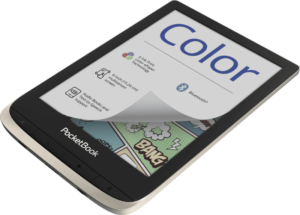Colour e-ink displays now appear as an e-reader product
Article 
Pocketbook Color eReader Hands on Review | Good EReader
Pocketbook Color: eBook-Reader bekennt Farbe (Pocketbook Color: eBook reader shows its colours) | Computer Bild (German Language / Deutsche Sprache)
From the horse’s mouth
PocketBook
PocketBook Color – the Swiss brand will release a new e-reader with color screen (Press Release)
PocketBook Color (Product Page)
Video – Click or tap to play on YouTube
My Comments
An e-book reader available on the European market is existing as a commercially-available example of a colour e-ink display.
E-ink is a display technology that works in a similar manner to ink on paper and uses existing light. It only consumes power every time the display is refreshed thus making it more power-efficient. It also works well in bright sunlight due to it not being dependent on a light source that can be easily “washed out” by the sun. Its main application has been handheld e-book readers but it has been limited to black-and-white display.
There has been work taking place to have e-ink displays capable of displaying in colour. It has come through in the form of the E-Ink Kaleido colour display which uses the same e-ink technology.
This has manifested in the Pocketbook Color which is an e-reader that has a colour e-ink display.
This EUR€199 device uses a 6” e-ink touch screen capable of displaying 4096 colours, with a resolution of 1072×1448. There is also LED lighting so you can use this device in darker settings. For audio, it can handle AAC, Ogg Vorbis and MP3 files, which can be played through earphones or a Bluetooth-connected audio device.
It has 16Gb of internal storage and can use SDHC memory cards, not sure what size, with a maximum capacity of 32Gb. This handheld device weighs in at 160 grams, something that would be acceptable for that class of device.
For e-book readers, the colour display may be seen as legitimate for visual novels or books that have colour photos or illustrations. Businesses may see it appealing for distributing brochures and catalogues in an electronic format for offline reading. As well, where colour is used to differentiate or highlight text in a book the colour e-reader will come in to its own here. A classic example of this is are the “red-letter” Bibles where the words of Jesus Christ are written in red.
But I also see the idea of a colour e-ink display appealing to other applications like colour digital signage in use cases where battery power is preferred. Examples of these would include outdoors use or freestanding signs. Or it could be about working towards making e-ink as a viable display alternative for laptops, tablets and smartphones where power efficiency is desired.
